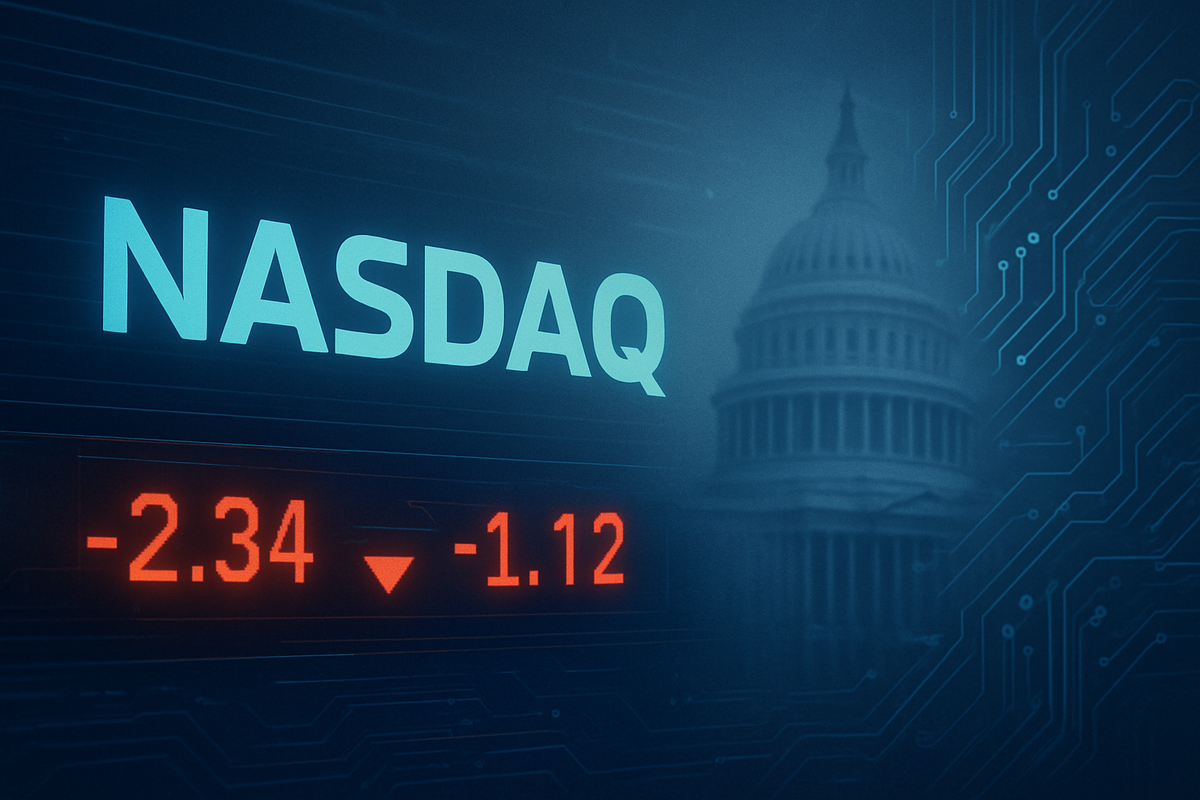
The longest U.S. government shutdown in modern history, a protracted 43-day impasse that began on October 1, 2025, officially concluded on Wednesday, November 12, 2025. While the nation breathed a collective sigh of relief as federal employees prepared to return to work on Thursday, November 13, 2025, the stock market's immediate reaction was far from celebratory. The tech-heavy Nasdaq Composite led the losses, signaling a significant recalibration of investor sentiment and casting a harsh spotlight on the sector's lofty valuations, particularly those tied to the burgeoning artificial intelligence (AI) boom.
On November 13, 2025, major U.S. stock indices trended downwards, with the Nasdaq Composite (NDAQ) falling 0.7% in early trading and deepening its decline to 1.1% by 10 AM ET. The S&P 500 (SPX) also saw a drop of 0.4% initially, settling at a 0.6% loss, while the Dow Jones Industrial Average (DJIA) dipped 0.2%. This immediate market reaction, despite the resolution of the political deadlock, underscored a prevailing investor caution, exacerbated by the absence of crucial economic data releases delayed by the shutdown. The tech sector, a significant driver of market gains throughout the year, appeared particularly vulnerable to this shift, prompting comparisons to historical speculative bubbles.
The Aftermath of a Historic Impasse: Details, Timeline, and Sentiment
The 43-day government shutdown, spanning from October 1 to November 12, 2025, stemmed from a profound legislative deadlock over budget appropriations for the 2026 fiscal year. At its core was a fierce disagreement concerning the expiration of enhanced tax credits for Americans enrolled in Affordable Care Act (ACA) health insurance, with a Republican-controlled House and a divided Senate unable to find common ground. The failure to pass either the 12 annual appropriation bills or a temporary continuing resolution plunged the federal government into an unprecedented closure.
Throughout October, non-essential government operations ceased, leading to hundreds of thousands of federal employees being furloughed or working without pay. Services ranging from national parks to critical economic data releases were disrupted, and the specter of federal worker layoffs loomed large. Public sentiment grew increasingly negative, with a majority of Americans expressing concern and nearly half reporting personal or community impacts by early November. Blame was broadly distributed among Congress and President Donald Trump, whose approval ratings soured as the shutdown dragged on.
The resolution, achieved through intense bipartisan negotiations, began to materialize in early November. A breakthrough occurred between November 7-9, with moderate senators from both parties brokering a deal. This agreement, passed by the Senate on November 10 and the House on November 12, included full-year funding for several key departments and a commitment for a future vote on the ACA tax credits by mid-December. President Trump's signature on November 12 officially ended the shutdown. However, the market's initial dip on November 13, despite the relief of a resolution, suggested that investors were still grappling with underlying economic uncertainties and the implications of delayed data, rather than celebrating a clear path forward.
Tech's Uneven Terrain: Winners and Losers in the Post-Shutdown Market
The immediate post-shutdown market on November 13, 2025, painted a stark picture of divergence within the tech sector. While some companies faced significant headwinds, others demonstrated resilience, highlighting the market's increased scrutiny of valuations and fundamentals in an environment of lingering uncertainty.
Leading the losses were many prominent AI-linked technology companies, whose high valuations had been a subject of increasing debate. Shares of Nvidia (NVDA) fell 2.9%, Palantir Technologies (PLTR) declined between 2.9% and 3.4%, and Super Micro Computer (SMCI) lost between 2.6% and 4.2%. Other AI-centric firms like Tesla (TSLA), Arm Holdings (ARM), AppLovin (APP), Shopify (SHOP), Broadcom (AVGO), and Alphabet (GOOGL) also saw their shares drop significantly. This broad decline was primarily driven by investor rotation out of high-multiple growth stocks due to valuation concerns, a perceived cooling of the AI trade, and broader macroeconomic uncertainty exacerbated by the data vacuum created by the shutdown.
The entertainment sector also felt the pinch. The Walt Disney Co. (DIS) saw its stock sink by 7.9% following a report of mixed quarterly earnings, with continued declines in its linear TV business outweighing growth in Disney+ and Hulu subscribers. Similarly, Flutter Entertainment (FLUT) and WEBTOON Entertainment (WBTN) experienced sharp drops after cutting forecasts and projecting declining revenues, respectively. These losses underscore the impact of reduced consumer spending in an uncertain economic climate and the acceleration of pre-existing industry challenges like "cord-cutting."
However, not all tech companies suffered. Cisco Systems (CSCO) emerged as a notable winner, with its shares jumping between 4.3% and 7%. Cisco's strong performance was buoyed by better-than-expected profit and revenue reports, driven by robust demand for its networking equipment. This demand is critical for underpinning the massive data center expansion necessary for the AI boom. Cisco's success illustrates that companies providing essential infrastructure for strategic, high-growth areas can thrive even amidst broader market uncertainty, as businesses prioritize foundational investments over speculative plays.
Broader Implications: Trends, Ripple Effects, and Historical Echoes
The post-shutdown market reaction, particularly Nasdaq's decline, fits into several broader industry trends and carries significant wider implications for the tech sector and beyond. The event underscores a growing skepticism surrounding the "AI bubble," with many analysts drawing parallels to the speculative excesses of the dot-com era. While AI's transformative potential is undeniable, the "stratospheric" valuations of some companies, often running at significant losses, are facing increased scrutiny. Investors are shifting focus from pure hype to tangible returns and sustainable business models, a trend that was accelerated by the uncertainty following the shutdown.
The government shutdown itself created a cascade of ripple effects. Regulatory agencies vital to the tech sector, such as the Federal Communications Commission (FCC) and the National Institute of Standards and Technology (NIST), experienced significant operational slowdowns. This led to delays in licensing, equipment authorization, and the development of crucial standards for AI and cybersecurity, complicating product launches and compliance for tech companies. Furthermore, the Federal Trade Commission (FTC), a key enforcer of data privacy and antitrust laws, saw many of its services become unavailable, creating a temporary vacuum in consumer protection and competition enforcement.
Tech companies with government contracts faced immediate challenges due to frozen projects and delayed payments, straining cash flow. The shutdown also impacted the tech talent pipeline by halting visa processing and potentially driving federal tech employees and contractors to seek more stable opportunities in the private sector. Critically, national cybersecurity was compromised as agencies like the Cybersecurity and Infrastructure Security Agency (CISA) operated at reduced capacity, increasing vulnerabilities for both public and private infrastructure.
Historically, government shutdowns have had mixed, often modest, long-term impacts on financial markets, with the S&P 500 typically posting gains in the 12 months following a resolution. However, the current scenario differs due to the pre-existing high tech valuations and mounting AI bubble anxieties. Unlike some past shutdowns where markets rallied, the November 2025 losses for Nasdaq reflect internal tech sector stresses exacerbated by government instability, rather than a general economic downturn. This suggests a more discerning market, less willing to overlook fundamental weaknesses in the face of political uncertainty.
What Comes Next: Navigating the Path Forward
The conclusion of the government shutdown and the subsequent market volatility usher in a period of adjustment for the tech sector and the broader economy. In the short term, the market is poised for continued fluctuations as the backlog of crucial economic data – including jobs and inflation reports – is gradually released. This "information vacuum" has complicated the Federal Reserve's interest rate decisions, and the incoming data will likely trigger fresh volatility as investors gain a clearer picture of economic health. Consumer spending, dampened by missed federal paychecks and delayed benefits, is expected to see a gradual recovery, with backpay mitigating longer-term effects but the immediate "dislocation" taking weeks to unwind.
Longer-term, the impact of the shutdown on innovation and R&D could be significant. Disruptions to federal funding and grant processes, particularly in emerging fields like AI, risk slowing the pace of innovation and potentially allowing international competitors to gain ground. Concerns about talent retention and workforce disruptions, especially regarding visa processing and the "brain drain" from public service, will also persist. The ongoing scrutiny of tech valuations and the "AI bubble" is likely to continue, potentially driving a further rotation of investments from expensive mega-cap tech stocks towards more traditional, value-oriented sectors.
In response, tech companies will need to consider strategic pivots and adaptations. Diversifying revenue streams beyond government contracts, enhancing contingency planning for future political impasses, and potentially focusing more on international markets for talent and expansion will be crucial. Prioritizing cybersecurity resilience is also paramount, given the vulnerabilities exposed during the shutdown. Companies that emphasize operational efficiency and strategic investments in innovation, particularly in areas less dependent on government stability, are likely to fare better.
Emerging market opportunities include the continued strong demand for AI infrastructure, benefiting companies like AMD (AMD) and Cisco Systems (CSCO). Efforts towards manufacturing reshoring, particularly in semiconductors, also present avenues for growth. However, increased international competition, spurred by the instability of US governance, poses a long-term challenge to the nation's technological leadership.
Wrap-Up: A Resilient Yet Wary Market
The end of the 43-day U.S. government shutdown on November 12, 2025, and the subsequent Nasdaq-led losses on November 13, 2025, serve as a potent reminder of the intricate relationship between political stability and market sentiment. While the immediate relief of a reopened government is palpable, the tech sector, in particular, finds itself at a crossroads, navigating a landscape defined by heightened valuation scrutiny, the lingering specter of an "AI bubble," and the practical implications of regulatory and operational delays.
Moving forward, the market is likely to remain wary, prioritizing companies with robust fundamentals, clear paths to profitability, and diversified revenue streams. The period of "flying blind" due to delayed economic data will gradually subside, but the release of this information could introduce fresh volatility. Investors should closely monitor these incoming economic indicators, as they will heavily influence the Federal Reserve's stance on interest rates and broader market direction.
The lasting impact of this event lies not just in the immediate financial shifts, but in the reinforced need for resilience and adaptability within the tech industry. Companies must bolster their contingency plans, diversify their market exposure, and continue to innovate strategically, recognizing that political uncertainties can directly translate into market challenges. The demand for foundational technologies, especially those underpinning the AI revolution, will likely remain strong, but speculative growth will face a more discerning eye. What investors should watch for in the coming months are signs of sustained economic recovery, the pace of regulatory normalization, and clear evidence of tangible returns from AI investments, distinguishing sustainable growth from mere hype.
This content is intended for informational purposes only and is not financial advice







